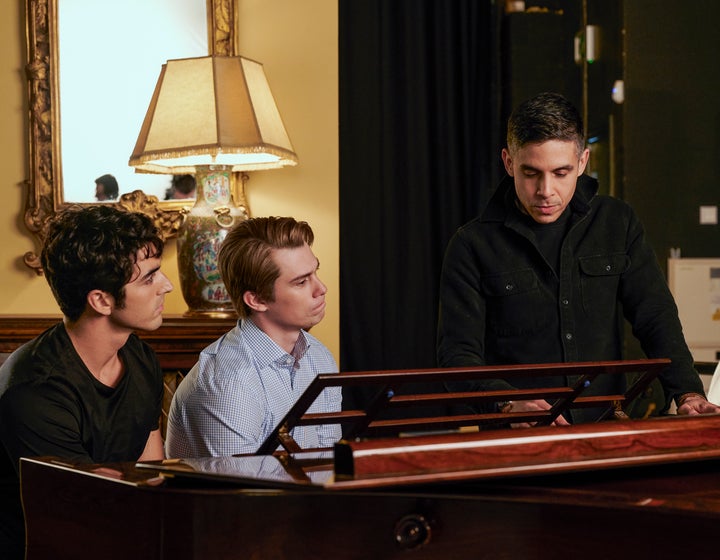‘Red, White & Royal Blue’ Director Discusses Movie’s Love Scenes
[ad_1]
Audiences eager to escape summer’s real-life heat for some on-screen sizzle should look no further than “Red, White & Royal Blue,” premiering Friday on Amazon Prime Video.
The film adaptation of Casey McQuiston’s 2019 novel follows a transcontinental romance between Alex Claremont-Diaz (played by Taylor Zakhar Perez), the son of the first female U.S. president, and Henry (Nicholas Galitzine), a British prince. It’s also surprisingly titillating, with its handsome protagonists expressing their pent-up passion for one another in hotel suites and the tack room at a polo match, among other glitzy locales.
Writer-director Matthew López has questioned whether those steamy scenes were enough to warrant the queer-themed romantic comedy’s R-rating. In an interview with HuffPost, however, he said he never considered making a more chaste film.
“What’s most important to me is that we understand Alex and Henry as a couple, in part through their sexual relationship,” said López, who co-wrote the film’s screenplay with Ted Malawer. “Anybody who ignored their great sexual desire would be missing a huge part of what makes the book special, and what makes it so unapologetically queer.”
Jonathan Prime/Prime Video
He went on to note: “Having spent my life watching what approximated for queer sex in films, I wanted to make sure that viewers understood unambiguously what was going on.”
At the start of “Red, White & Royal Blue,” Alex and Henry are bitter rivals. After an altercation at a royal wedding makes international headlines, the two men are coerced by their handlers to attempt a truce.
Over time, Alex and Henry forge an unlikely friendship that blossoms into a full-blown love affair. Still, the pair fear the political repercussions their respective families will face if their romance is made public.
“Red, White & Royal Blue” marks López’s feature directorial debut. The Florida native is beloved by Broadway audiences for his Tony-winning 2019 play “The Inheritance,” which depicted a group of gay men grappling with life, love and legacy in New York 20 years after the height of the HIV/AIDS epidemic.

Given the near-universal acclaim McQuiston’s novel has received, expectations for “Red, White & Royal Blue” are high. Last month, the book shot to the top of the bestseller lists once again amid early buzz for the movie.
As a big fan of the novel, López enthusiastically pursued the opportunity to adapt it for the screen. Still, he didn’t feel any undue pressure to fulfill anyone’s vision for the film but his own.
“The best thing I could do for fans of the book is to temporarily forget that they were there,” he said. As for the film’s cast, he added: “Seeing these two young, exciting, vibrant actors come together at this specific time in their careers, in service of two very beloved characters, is pretty special. I think it’s a one-in-a-million shot that we got these two and that they worked so well together. We never took that for granted.”
“Red, White & Royal Blue” is the first in a series of film and television projects López is developing through Amazon Studios. He’s also attached to a remake of the 1992 romantic drama “The Bodyguard,” which starred Kevin Costner and Whitney Houston.
Watch a scene from “Red, White & Royal Blue” below.
His theatrical career has reached new heights, too. Most recently, he teamed up with Amber Ruffin to adapt the classic 1959 film “Some Like It Hot” for Broadway. The pair added numerous characters of color to the cast and amped up a queer subplot that had only been alluded to in the original. The musical went on to win four Tony Awards in June.
Though López didn’t expect to be such a leader in making diverse, queer-inclusive storytelling for the stage and screen, it’s a role he’s happy to fill.
“I wish I could say I had a grand plan for my career and my life ― I don’t,” he said. “I’m drawn to characters who haven’t had a chance to have their stories told. A lot of the things I do, I do because I haven’t seen them. But I want to see them.”

[ad_2]
Source link
Things Homeowners Realized Too Late That They Despise About Their Houses
[ad_1]
Things Homeowners Realized Too Late That They Despise About Their Houses
[ad_2]
Source link
‘This environment is normal in Tokyo’: Jeff Liang’s best phone picture | Photography
[ad_1]
Reflecting on his three years in Japan, Taiwan-based photographer Jeff Liang says, “Someone said to me once that Japanese society is like nigiri rice – that’s a perfect ‘bowl’ of rice, formed with your hands: nothing can fall out, or stick out – every single grain of rice must stick together to make it work. In Japanese culture, conforming is deemed essential.”
He had arrived in Japan on a working holiday visa and found a job as a souvenir shop clerk in Osaka, before being hired as a photographer and designer for an app. His office was in Shibuya, one of Tokyo’s busiest areas. “I was working for a Taiwanese company though, so my working day was only 10am to 8pm. It sounds long, but that’s pretty short by Tokyo standards. From 8am to 10pm is more normal. People are afraid to leave early and make a bad impression.”
after newsletter promotion
As such, the commuter rush hour is not only one hour; instead, it’s more like four. “It begins by 6am, through to 10am, and then again from 6pm to 10pm.” In those periods, finding a seat on his daily 40-minute commutes, when this photo was taken, was almost impossible. But while he always found it stressful, “something to be endured”, he notes that the faces he captured around him are relaxed, comfortable even.
“These hours and this environment is normal in Tokyo. But it’s also the reason why you see so many people passed out drunk on the streets at night. They have to be a certain way for their work, and the commute is part of that. Afterwards, they can free themselves. But the next morning, it starts again.”
[ad_2]
Source link
Fire damages abandoned Pittsburg theater – The Mercury News
[ad_1]
Fire damages abandoned Pittsburg theater The Mercury News
[ad_2]
Source link
Come together: the democracy of the symphony – music’s greatest form? | Classical music
[ad_1]
You are rarely more than a few days away from a symphony at the Proms, but at the Albert Hall this coming week it is a particularly big one for the orchestral statement piece that’s been at the heart of the classical music tradition since, well, roughly the French revolution. On 13 August it’s canonic centrepiece Beethoven’s Symphony No 3, known as the Eroica (Heroic), then through the following week further crowd-pleasers Shostakovich’s Symphony No 10 and Mahler’s Third Symphony. Moving beyond the heavyweights, the programme also features a symphonic gem composed by Croatian Dora Pejačević (1885-1923) during the first world war while she was working as a nurse, and a work that’s fresh off the press.
How can this single form have had such an enduring hold over the imaginations of composers and audiences alike for (at least) two-and-a-half centuries? What, exactly, is the symphony’s secret?
The roots of the genre lie in opera. Composers around Milan in the early to mid-18th century developed the instrumental overtures that preceded the onstage action, often known as sinfonia, into a stand-alone form. But it was when composers in Vienna got involved – first Haydn, then Mozart and Beethoven – that things really began to take off. Ensembles got meatier, adding wind and brass, and so did the symphony’s musical ambitions, focusing on the evolution of one kernel-like theme over – usually – four complementary sections, called movements, each with a different musical character. (Side note: typically people don’t clap between movements, but life is far too short for it to matter if you do.)
Much of the reason the symphony has maintained such heft since then is because it supposedly represents timeless values. It has a tricksy ability to tread a line between repelling meaning – ie it’s pure music, not about anything except music – and attracting meaning like iron filings to a magnet. Not just any old meaning, though. Big and important meanings with philosophical grandeur, about self and society. And it is when symphonies succeed in tapping into a vision of our collective ideals – the society we would like to live in, the people we’d most like to be – that they really shine.
Symphony means sounding together. Not for nothing has the musical form long been linked to the idea of democracy – boots on a march, voices in a protest – with 19th-century thinkers arguing that all the instruments playing their parts to make a whole modelled the harmonious functioning of society. (It is also true that symphonic music’s collective idealism has proved politically unscrupulous, and many pieces bear the memory of their use as a soundtrack within totalitarian regimes.)
It was Beethoven’s Eroica that gave us the origin story for symphonies being interpreted as a vision of heroic struggle and triumph, of human self-realisation in the face of adversity. The status of instrumental music within the hierarchy of artistic forms shifted in the early 19th century when the Romantic philosophers stormed in with newfangled ideas about music’s preeminence among the arts. Putting Beethoven’s symphonies right in the foreground of this new philosophy, writers such as ETA Hoffmann (better known for his gothic horror) argued that symphonic music was transcendent, transporting us into an “unknown realm” that revealed universal truths about human yearnings.
Critics and audiences have been enthralled ever since by a genre they believed told bold, powerful or tragic stories about what it means to exist. Think of Mahler building whole worlds for the listener to inhabit; Florence Price insisting on her Black American musical heritage in her symphonies by subtly (and not so subtly, in the case of her syncopated Juba dance movements) weaving musical techniques inspired by African American musical traditions through her scores; Shostakovich expressing the misery of life in Stalinist Russia, where even your thoughts were barely your own, through musical veils and mirrors – most famously, we hear his gritted teeth as he seemingly bombastically celebrates the regime in the fifth symphony. All convey a sense of subjective struggle.
Beethoven’s hero in question was none other than Napoleon Bonaparte, to whom he initially dedicated the Eroica (although the dedication was later forcefully scratched out). As the story goes, the Eroica was intended to celebrate Napoleon’s status as a liberal humanist revolutionary; when Napoleon declared himself Emperor of the French, becoming “a tyrant”, it was more than Beethoven could stomach. (Although the story was likely not quite as clearcut as this.)
And that is all well and good if you are the kind of person who wakes up with a hankering to conquer the Holy Roman empire. But what if you’re just going about your 21st-century business of recovering from a pandemic? In an era of social justice movements that emphasise diversity of experience, it also becomes harder to believe in the Romantic universals that the symphonies of Beethoven and other composers (nearly all of whom are dead white European men) have been taken to represent.

Do symphonies and the values they represent still matter now? Samy Moussa, whose terse one-movement Symphony No 2 will enjoy its European premiere at the Proms, certainly thinks so. “[The symphony is] the wish of the composer to be universal,” he tells me from Montreal. What he suggests the form offers 21st-century composers is the opportunity to participate in an important act of cultural continuity, to sustain something greater than themselves into the future. “You’re just part of something, a tiny little part of it,” Moussa says. Rather than the egos of individual composers, it is the symphonic tradition that he believes matters.
Perhaps rightly so: with almost a weight of its own, the symphonic tradition is incredible – and wildly varied. And the very question of what a symphony actually is is not a subject for the faint of heart – the number of exceptions to almost any given definition is so great that the only thing that really makes something a symphony is the fact that a composer called it one. The crown for the longest ever may go to British composer Havergal Brian, whose Gothic Symphony clocks in at a bladder-testing one hour and 45 minutes. Naming the shortest is harder – although a solid choice to have up your sleeve is Anton Webern’s two-movement Op 21 that lasts around nine minutes, because Webern explores brevity itself, purposefully collapsing the late-Romantic monumental hero complex.
But all this earnestness isn’t to say there hasn’t been any symphonic fun (Haydn’s Surprise symphony, anyone?), and plenty tend towards the weird and the wonderful. For the strangest, perhaps try Nikolai Myaskovsky’s Collective Farm Symphony, an example of Soviet realist aesthetics. And any of the iconoclastic works of American composer-cum-insurance salesman Charles Ives would do for the most wonderful. Ives liked to do things like have multiple orchestras playing at once, as in his (sadly unfinished) Universe Symphony.
While it can be hard to feel especially heroic in 2023, perhaps what we need from symphonies is a reminder that we, like Napoleon et al, can withstand difficult things. The history of the symphony has undeniably been shaped by exclusion: if it hadn’t, you would be much more likely to have already heard of Dora Pejačević. Reaching back to those collective ideals, at their best symphonies might also remind us that we’re all in it together, and that democracy isn’t dead – what it means to “sound together” but also to listen with hope for something unknown and beautiful.
[ad_2]
Source link
U.S. Ballet Companies’ Budgets Dropped By Almost A Third In FY2021
[ad_1]
The first full fiscal year of the COVID-19 pandemic saw a drop in aggregate spending by the largest 150 classically-based companies of 31.62% from FY 2020 and 39% from FY2019. – Dance Data Project
[ad_2]
Source link
Destination Design: NICO in Sayulita, Mexico
[ad_1]
Situated along the jungle-lined coast just an hour north of Puerto Vallarta in the bohemian surf town of Sayulita, Mexico, Seattle-based architecture and development firm, HYBRID in collaboration with Mexico City-based architecture firm Palma, have opened a 3,000-square-foot architectural rental operating on numerous levels of luxurious comforts.
From street level, NICO Sayulita’s front facing impression presents itself as a two-level structure. Only after guests cross a bridge over the main pool does the entirety of the structure reveal itself with a tiered sunken site imprint designed to disappear into the canopy of tropical foliage.

Aimed at travelers seeking a refuge from loud luxury for intimate privacy, NICO’s open architecture is carefully planned for surprising seclusion.
A series of elevated suites and open-air common spaces are connected by floating staircases in Escher-esque style. Indoor and outdoor spaces intermingle into a concrete grid structure, maximizing the welcome cooling effect of the ocean breeze across both private and shared spaces.
The efficient grid-like design allows for a “gradient of privacy and openness.” Sections of the building can be connected or closed off in accordance of desired level of privacy, making the rental ideal for families or a large group of friends staying together.
NICO was conceived to offer a micro-boutique tropical getaway experience while retaining several hotel-style options to keep any stay north of just a typical home rental (suites can be rented in combination with the option to rent out the entire house). These include practical needs, including airport transportation, daily cleaning, and laundry services, but NICO’s owners also remember being on vacation means feeling pampered, so there’s also the option to hire the services of a bartender, chef, yoga instructor, massage therapists, surfing instructor, or a guide for local excursions.

NICO Sayulita’s Jungle suite resides on the floor level, with lush tropical foliage and its own built-in concrete tub for a spa-like experience situated indoors.
“The suites are generally calming tranquil spaces with views to the jungle environment,” says Robert Humble, Founding Partner and Design Principal at HYBRID. “A neutral color palette of concrete, steel, and wood imbues a sense of craft and refuge. The common spaces are more brightly colored and playful to excite the senses and create a memorable experience.”

Loma Alta’s 5 bedrooms are furnished with either a king size bed or two individual beds. Two daybeds are also available for guests staying individually.

Every room is furnished in a serene organic-modern style, with pieces sourced from emerging Mexican designers.

Guests cross a small bridge over a small saltwater lap pool detailed with artisanal turquoise-colored tile and surrounded by greenery.
What: NICO
Where: Calle Loma Alta 7, 6373 Sayulita, Mexico
How much: Starting from $840/night for 5 bedrooms; 5-12 guests with 5-12 beds, 6 bathrooms
Highlights: A rooftop plunge pool offering spectacular views of the bay, and the Jungle suite’s built-in concrete circular tub.
Design draw: The NICO’s multi-tiered tropical modernist concrete structure interconnected by floating staircases is an inviting interplay between public and private spaces, the natural landscape in relation to its architectural imprint. Furnishings within are sourced from emerging Mexican designers.
Book it: NICO
Go virtually on vacation with more design destinations right here.
[ad_2]
Source link
The week in art news – Brice Marden (1938–2023)
[ad_1]
The painter Brice Marden has died at the age of 84. Marden drew from both Abstract Expressionism and minimalism over the course of his long career – but through tireless experimentation with his medium, he forged a style that was entirely his own. His first solo exhibition, which took place at Bykert Gallery in New York in 1966, included a series of monochromatic matte surfaces created by mixing oil paint with beeswax. The critical acclaim garnered by the show propelled him to the front rank of American painters while he was still in his twenties. In 2006, Marden was the accorded a career-defining retrospective at the Museum of Modern Art; the Wall Street Journal claimed he was ‘among the handful of living artists established enough to be considered part of art history.’ The artist, who had been battling cancer, continued to paint throughout his final years.
The Ukrainian government has released an online database listing artworks in the possession of Russian nationals currently under sanctions. The ‘War & Art’ database details paintings, sculptures and other artworks that have been bought and sold since the Russo-Ukrainian war began in 2014. According to the country’s National Agency on Corruption Prevention, its aim is to ‘make it difficult for Russian oligarchs’ to launder money and ‘make it easier for virtuous art market participants to carry out sanctions checks’.
The island of Maui in Hawaii has been devastated by wildfires that have killed at least 36 people and damaged more than 271 structures. Jonathan Yukio Clark, the director of the Schaefer International Gallery at the Maui Arts and Cultural Center, told the Art Newspaper that ‘it will take time to know the full impact and specifics’ of the damage to the island’s museums and heritage sites – but reports have suggested that it is severe. Front Street, part of the old town of Lahaina and home to a number of historic buildings, has been entirely destroyed; a CNN report suggests that the same fate has been suffered by the Baldwin Home Museum, which was believed to be the oldest building on the island dating back to 1834.
The Chrysler Museum of Art in Norfolk, Virginia has agreed to return a 19th-century marble sculpture titled The Wounded Indian (1850) to the Massachusetts Charitable Mechanic Association (MCMA), putting an end to a 20-year dispute over its ownership. The work, by British sculpture Peter Stephenson, was acquired by the MCMA in 1893 before it disappeared when the charity moved premises in 1958. It is believed to be the first life-size sculpture made entirely of marble to have been created in the United States.
An artwork consisting of 115 gold-painted statues of Wagner has disappeared in its entirety from the garden of the Bayreuth Festival Theatre in Germany. The artist Ottmar Hörl has stated that individual figurines have been taken as souvenirs by visitors, but believes that the wholesale disappearance overnight of the work titled You’re Welcome (2023) is the work of art thieves. The Bayreuth City Police Inspectorate has launched an investigation.
[ad_2]
Source link
How to Become Famous in 3 Shockingly Easy Steps – Skinny Artist
[ad_1]
Let’s face it, you’ve probably been working way too hard.
Forget about all of those years toiling away in obscurity
Forget about putting in your 10,000 hours of practice to master your craft.
In fact, forget about creating any creative work at all, now it’s all about becoming famous for the sake of being famous.
Somewhere along the way, fame has become a goal in itself. It’s not necessarily to become a famous musician, a famous writer, or a famous artist — it’s simply enough to become famous.
Creative artists have always been provocateurs. Artists such as Picasso, Duchamp, O’Keeffe, Cerny, Pollock, Banksy, Christo, and Hirst specialized in works that stir the emotions and push the boundaries (and buttons) of their viewing audience. Their primary purpose, however, was never simply to get attention, it was an attempt to alter our perspective and offer us something new using their own unique creative voice.
Now having said that, why does it feel like so many of us these days are just screaming to get attention?
Breaking through the Background Noise
Look I get it, the internet is getting awfully crowded.
Now that virtually everyone has their own Twitter account, Facebook page, YouTube channel, and blog — it has become harder than ever to breakthrough the background chatter and get ourselves noticed. We’ve got more news outlets and low-cost ways to spread our creative work around than ever before.
What seems to be disappearing, however, is our attention.
So what happened?
There are no spectators any more.
You have to remember that not that long ago there were only a handful of television channels, movie studios, and music recording companies out there. They produced the content and we dutifully watched, listened, and purchased whatever it was they created.
It didn’t even have to be all that good because we only had a few choices available to choose from (unless of course, you were one of those weird “book readers”). They had the professional actors and musicians, and we were the spectators. They performed while we sat on the sidelines clapping and purchasing our tickets.
Back then we even watched the commercials on TV because we were simply too lazy to get up and change the channel. It was the glory days of Mad Men and everyone played their part — They talked and we listened.
But here’s the problem….things changed
No one is listening
The world wide web has changed all of that. There are no more spectators sitting on the sidelines waiting to be entertained because we all to some degree have become content creators ourselves.
We are now so busy creating and sharing our own content that we don’t have the time to notice anyone else’s stuff.
We update our blog, we blast out dozens of Facebook and Twitter updates daily only to discover that fewer and fewer people are listening to what we have to say. So we end up spending the majority of our time talking about (and to) ourselves.
It’s kind of like Thanksgiving dinner, where everyone is talking at the same time but no one is really listening. We are simply talking over one another. The conversation around the table keeps getting louder and louder until you can’t even hear what you are saying yourself.
In economics, this is called the law of diminishing returns. In other words, the first person to start shouting in a quiet room is almost guaranteed to get noticed. Maybe even the second of the third person as well–but as soon as everyone in the room starts shouting, nobody can hear anyone and we just tune it out. Unfortunately, it seems that we have now reached that point online where everyone is shouting to get themselves noticed but nobody is bothering to listen anymore.
When everyone is standing, nobody can see
So in this type of environment where there is already so much noise and commotion, how can anyone ever hope to stand out and get themselves noticed?
Well this all comes back to the title of this post which is “How to Become Famous in 3 Shockingly Easy Steps”
(you weren’t sure we’d actually get back there did you?)
So here it is…. the secret to getting yourself noticed online is to shock your audience into paying attention to you.
Shock & Awe
Let’s face it, the fastest way to get attention is to scream
Shock = Attention = Fame
As you can see, our formula here is fairly simple. If you want to become famous, you’ve simply have to find a way to get people’s attention. Once you get people’s attention, you become famous.
You see fame (unlike talent) is nothing more than capturing someone’s attention.
Shocking people by doing something stupid and outlandish used to be the province of disc jockeys, graffiti artists, and Jerry Springer but now it has apparently become mainstream.
So not only is Picasso famous for his artwork but now so is the idiot who walked into a museum and vandalized one of his paintings. It doesn’t take talent, hard work, or skill to become famous. All it really takes is the ability to capture someone else’s attention by doing something completely unexpected. It doesn’t even matter whether you do something “good” or something “bad” to get attention — the result is exactly the same.
Fame you’ll be famous, as famous as can be, with everyone watching you win on TV, Except when they don’t because sometimes they won’t. ~Dr. Seuss
And it’s not just beginners who are struggling to get noticed, it’s also those who may already be famous but want to become even more famous. Do you think that it’s merely coincidence that so many washed up celebrities publicly announce the fact they are checking into rehab or “accidentally” leak a sex tape. Even these B-list celebrities understand that fame demands attention, and if they are no longer getting enough attention, they need to do something that will.
As a culture we used to try and hide these little indiscretions, now we go out of our way to record and publicize them.
This tried and true formula has revived the careers fame of countless actors and musicians who have then gone on to a lucrative second career in reality television. After all, everyone loves to tune into Bravo and watch a good celebrity train wreck because it makes us feel morally superior to these idiots and their self-serving shenanigans.
Okay, that’s great, but what if you’re not already a washed up celebrity? What are your options?
Well lucky for you, there have been plenty of other people who have used controversy to worm their way into our collective consciousness. In the process, they’ve left us a detailed blueprint on how to become famous for being infamous.
So without further adieu, I bring you…
The Idiot’s Guide to Becoming Famous with Minimal Effort
Step 1.) Do something incredibly stupid and obnoxious to attract attention to yourself
Don’t be afraid to think outside the box here. This can be in the form of a video, stunt, hoax, or just good old-fashioned vandalism. Keep in mind that as a culture we have become somewhat desensitized to people doing stupid things from years of watching people do stupid things, so try to think big.
Step 2.) Be sure to record your act of stupidity and publish it on YouTube.
Remember that recording and documenting your act of idiocy is not optional here. These days if you don’t capture something on video, you might as well go back to live in your primitive cave of obscurity.
It’s the whole tree falling in the forest kind of thing. This isn’t 2005 and nobody wants to sit down and read about it in some old-fashioned newspaper, they want to actually see it happen so they can shake their head in disbelief as they are clicking on the share buttons.
Although it’s true that you might get fined or arrested for your stunt, don’t worry about it because you will also get your name in the papers, the blogs, cable news channels, and other ridiculous websites (like this one) that have nothing better to do than to give you more free publicity.
Just make sure that they spell your name correctly.
Step 3.) Get rewarded for your idiocy and bask in your new-found fame
Congratulations you are now famous! Please keep in mind, however, that although your fame may be immediate, it is far from permanent. So while you are soaking in your 15 minutes of fame, be sure to be thinking about your next public spectacle of stupidity. Because as much as we enjoy watching your personal train-wreck on YouTube, there is always another idiot just around the corner waiting to shock and amuse us.
Then again, there is nothing wrong with fame itself.
Don’t get the wrong idea here. There is nothing wrong with being famous. Just as there is no inherent goodness from spending your life toiling in obscurity.
Being famous doesn’t make you any better of a creative artist. In fact, those who achieve a certain amount of fame often feel trapped by it (I know boo-boo right?). As soon as someone achieves some degree of fame and success, however, the temptation is always there for them to stick with that same tried-and-true formula, instead of risking potential failure by trying something new. They find themselves suddenly trapped in a creative rut because of the expectations of their audience.
I never wanted to be famous. I only wanted to be great. ~Ray Charles
Fame is (or at least should be) the public recognition that you have achieved some degree of mastery in your chosen profession. What fame shouldn’t be, however, is a goal in itself.
So maybe we should stop wasting all of this energy trying to get ourselves noticed and perhaps spend some of that time working on becoming a better creative artist.
Despite what you may have heard, there are no shortcuts.
There is no “easy” button.
You just have to sit down and do the work.
What do you think?
- What is your take on our celebrity obsessed culture?
- Do you think we are sending the wrong message by rewarding art vandals with their own gallery show?
- When exactly does getting “noticed” and marketing ourselves as an artist cross the line?
[ad_2]
Source link
#FromOurWebsite⠀⠀⠀⠀⠀ ‘Mad Milky Way’ by @carl_kenz…
#FromOurWebsite⠀⠀⠀⠀⠀
‘Mad Milky Way’ by @carl_kenz in #Germany⠀
–⠀⠀⠀⠀⠀⠀
This image was uploaded to globalstreetart.com add your shots to get featured in this feed.⠀⠀⠀⠀⠀⠀⠀
–⠀⠀⠀⠀⠀⠀⠀
#GlobalStreetArt #Streetart #PaintedCities https://www.instagram.com/p/BuUJtZNno2P/
Striking Hollywood Writers, Studios Meet To Discuss Resuming Talks
[ad_1]
LOS ANGELES (Reuters) -As the Hollywood writers’ strike approaches the 100-day mark, Writers Guild of America (WGA) negotiators met on Friday with representatives of the major studios for the first time in three months to discuss whether contract talks can resume.
The 11,500 members of the guild walked out May 2, citing an impasse over pay, streaming residuals and other issues such as setting curbs on the use of artificial intelligence. Next Wednesday marks the 100th day of the strike.
Los Angeles Mayor Karen Bass said she was encouraged by the reopening of communication, as the Hollywood writers’ and actors’ dual strikes negatively impact the economy.
“It is critical that this gets resolved immediately so that Los Angeles gets back on track and I stand ready to personally engage with all the stakeholders in any way possible to help get this done,” Bass said in a statement.
Neither the WGA nor the Alliance of Motion Picture and Television Producers (AMPTP), which negotiates on behalf of Walt Disney, Netflix, had given any updates on the talks by mid-afternoon.
But ahead of Friday’s meeting, they traded pointed statements.
The WGA’s negotiating committee said it was time for the studios to abandon the tactics they used during the previous writers’ strike in 2007-08, including allegedly spreading misinformation about the real impact of the strike.
“We challenge the studios and AMPTP to come to the meeting they called for this Friday with a new playbook,” the WGA said in an email. “Be willing to make a fair deal and begin to repair the damage your strikes and your business practices have caused the workers in this industry.”
The AMPTP called the WGA rhetoric “unfortunate.”
“Tomorrow’s discussion with the WGA is to determine whether we have a willing bargaining partner,” the AMPTP said in a statement, adding “Our only playbook is getting people back to work.”
Previously, the group said it had offered writers generous increases in compensation, and put forward improvements in the residuals paid to writers for making their movies and TV shows available on streaming services.

David Livingston via Getty Images
The work stoppage is taking a toll on florists, caterers, costume suppliers and other small businesses that support the entertainment industry. Those impacts were magnified, on July 14, when members of the Screen Actors Guild went on strike, after being unable to reach an agreement with the studios on a new three-year contract.
The AMPTP issued a statement, saying the actors had walked away from more than $1 billion in wage increases, pension and health contributions and residual increases.
The twin job actions are rippling broadly through the entertainment industry, halting most work on scripted series for the fall TV season as well as film production.
Fox is expected to announce that television’s Emmy Awards will be rescheduled to air in January due to the strikes, the Los Angeles Times reported, citing a person familiar with the plans.
Meanwhile, Warner Bros Discovery warned investors Thursday that uncertainty over the dual strikes could delay film releases and impact its ability to produce and deliver content.
(Reporting by Dawn Chmielewski in Los Angeles; additional reporting by Danielle Broadway in Los AngelesEditing by Mary Milliken and David Gregorio)
[ad_2]
Source link
Painting Of Donald Trump Chilling With Other GOP Presidents Gets Scathing Reworking
[ad_1]
Artist Andy Thomas’ piece, titled “The Republican Club,” depicted Trump shooting the breeze with other GOP presidents. Here it is:
Well, New York artist Michael D’Antuono, 62, has reimagined the work in accordance with how he believes the scene would really play out.
And he doesn’t believe Trump will be hanging his painting, titled “Party Pooper,” in the official residence anytime soon:
D’Antuono’s version shows Trump facing the wrath of the other presidents for cheating at cards. Protesters stand outside the window, and the Trump baby blimp also makes a subtle appearance.
“As in life, Trump literally shrugs off the outrage caused by his double-dealing chicanery,” D’Antuono said in a statement sent to HuffPost Thursday.
“While the painting highlights Trump’s inability to feel shame, the real message is that the Republican presidents of past generations (and their constituents) would not approve of what Trump represents,” he added. “The protesters in the window suggest the reasons that the majority of Americans feel the same.”
[ad_2]
Source link


















